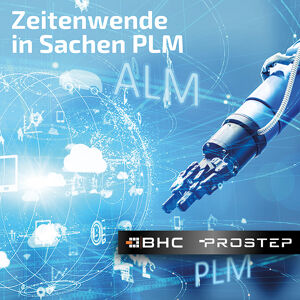Application lifecycle management (ALM) could become a game changer in PLM environments. A joint study conducted by PROSTEP and BHC analyzes the associated market and application environment. In an interview with our guest author Dr. Bernhard Valnion, agricultural machinery manufacturer CLAAS explains why it decided to focus on one tool provider when choosing a PLM platform.
The aim of the joint study conducted by PROSTEP AG (Darmstadt) and BHC GmbH (Böblingen) was to determine the current allocation of roles between PLM and ALM when developing mechatronic and software-intensive products and to identify companies’ future strategy for systems lifecycle management (SLM). For this purpose, the authors of the study interviewed managers and specialists from leading companies in the automotive, mechanical engineering, electrical and medical engineering industries. The largest of the companies had approximately 400,000 employees, the smallest 100.
The following statement illustrates why ALM is becoming increasingly important: “Cars are becoming smartphones on wheels. If we are to remain competitive, we not only have to get to grips with the hardware but also the software,” Ola Källenius, chairman of the board of management of Mercedes-Benz Group, was recently quoted by the German newspaper Handelsblatt. And to do this, they are prepared to invest billions. This is because it demands a whole new quality of ALM to perform verifiably valid over-the-air updates for example. One of the issues involved is ensuring the end-to-end traceability of information throughout the entire product lifecycle.
No traceability across disciplines
The study indicates that there are still gaps in this traceability. Although the authors of the study awarded high marks for the integration of mechanical development artifacts, this is hardly surprising given that PLM has its origin in mechanical engineering. Electronic development and electrical engineering project planning are also well on the way to achieving this, as Peter Wittkop, Lead Expert PLM Strategy & Processes at PROSTEP AG and one of the study’s authors, explains. [Link to article] Software development in itself functions well, or even very well, as an isolated solution. “The question, however, is how software development can be integrated in the context of a complete product description.” The existence of ALM and PLM in separate worlds means that “scarcely any company can ensure the full traceability of deliverables across different disciplines, even though most of them consider this a key future requirement,” Peter Wittkop goes on to say.
The study was conducted with regard to the design options in processes, organization and IT/tools. In the context of process design, for example, the question is which path for introducing requirements management should be selected. Should the path involving a functional system model be taken? In organizational terms, the question is, for example, what incentives could be used to encourage employees to play an active role in shaping the transformation of the companies.
The study also takes a critical look at the portfolio strategy of the system vendors. The truth is that the vast majority of respondents do not aim to meet all engineering challenges with a single-vendor solution. Instead, there is a tendency towards a best-of-breed approach. Peter Wittkop: “The tendency to turn our backs on monolithic systems in which everything is stored is striking.”
CLAAS is pursuing a few-vendor strategy
In an interview with the trade journal d1g1tal AGENDA, Jan Wilhelm Gröver, Head of Systems Lifecycle Management at CLAAS, [link to interview] explains why the renowned agricultural machinery manufacturer has opted for a few-vendor strategy rather than a best-of-breed approach. The focus is on a close partnership with Dassault Systèmes for PLM and Microsoft for ALM, because: “Our aim is to reduce complexity. After all, considerable resources are tied up in developing the interfaces. That is why our maxim is: as little customization of the tools as possible. Strategic partnerships with tool vendors make this possible and also allow us to participate in the further development of their portfolios.”
Jan Gröver goes on to say that a major issue on the path to end-to-end systems engineering is the systematic mapping of requirements management. The first project was launched in 2014. CLAAS now systematically records all machine-specific requirements in a requirements management tool. “We want to achieve a productive model-based systems engineering practice between 2025 and 2030.” Jan Gröver explains that this is referred to as a “journey”, not a project with a predefined end date.
Be that as it may, what is needed are competent analysts like PROSTEP and BHC, who monitor PLM and ALM system vendors with a critical eye and provide customers with recommendations for action based on experience gained in previous projects. Wittkop concludes that it is very important that sufficient attention is paid to the customer’s initial situation.

About Dr. Bernhard D. Valnion
Dr. Bernhard D. Valnion has followed the CAx industry as an editor, analyst and publicist for over 20 years. He is CEO, founder and president of d1g1tal AGENDA UG, which among other things publishes the magazine d1g1tal AGENDA quarterly. It also offers the sub brands d1g1tal HUMAN (podcast about movers and shakers in the age of digitalization) and d1g1tal LOOPs (process mining).
